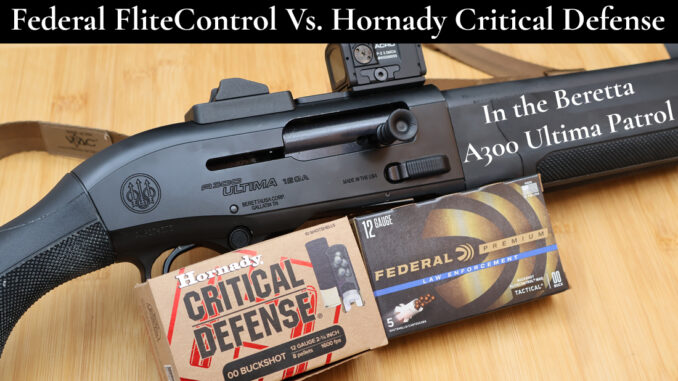
Here at PrimerPeak, we’re fans of the Beretta A300 Ultima Patrol. Dan reviewed his back in 2023, and I’ve been testing mine since Spring 2024. The shotguns are great shooters, with light recoil and extremely good reliability. However, I wanted to pattern my specific gun, to see how well it performs. I did some patterning last year, but it was not particularly scientific nor clean. Well, I’ve changed that, and have testing of a few popular loads of buckshot through my A300. How well does Federal FliteControl 8 Pellet and Hornady Critical Defense perform in my shotgun?
The Shotgun
Before I talk about the buckshot, let’s discuss the scattergun used for testing.
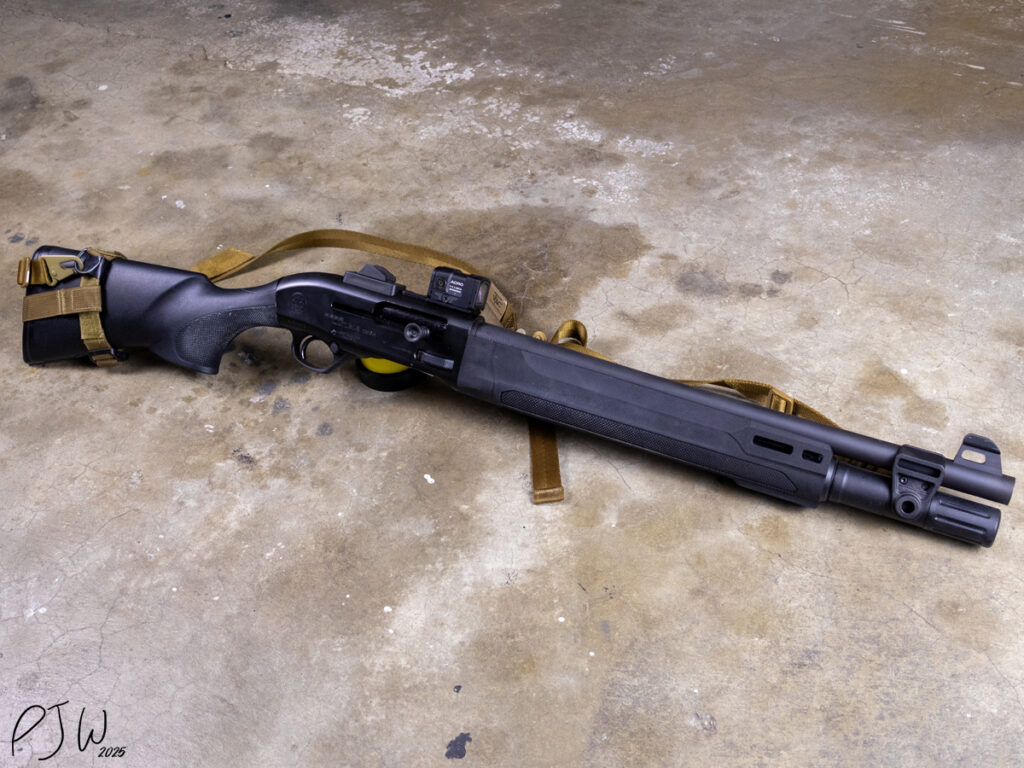
My A300UP has a lot of goodies bolted onto it:
- An optic (Aimpoint P-2)
- A sling (VTAC Mk1)
- A Weapon Mounted Light (Surefire X300T)
- Sidesaddle (Esstac Shotgun Cards)
While I’ve outfitted the shotgun to be the defensive scattergun that I desire, I’ve not modified the internals. This A300 is bone-stock on the inside, which includes the barrel and choke system. The A300UP ships with a 19″ cylinder barrel, and an Improved Cylinder already installed choke. For my testing, I’ve run the gun with that OEM IC choke. IC will pattern slightly tighter than a normal cylinder bore shotgun. On a defensive shotgun this is nice to have, and we’ll take every benefit that we can.
Before I get into the loads and testing parameters, I do want to mention independent testing. My testing is on my specific shotgun. Every shotgun and shotgun barrel is an independent example, so your results may very, even in the A300UP. That said, I have found these loads to be fairly representative for a lot of shotguns across the board.
So what were these loads, and how did I test them?
Setting the Stage – Federal FliteControl Vs. Hornady Critical Defense
My 2024 testing was consistent, but not clean. I wanted to rectify that here, and did so in the form of better understanding the ammo, and setting tighter parameters.
The Loads
For my testing, I had three 00 buckshot loads that I wanted to pattern.
- Fiocchi 9 Pellet 00 Buck (acts as a control load)
- Hornady Critical Defense 8 Pellet 00 Buck
- Federal FliteControl 8 Pellet 00 Buck (LE13300)
The main goal was to pit the Hornady Critical Defense (CD) buckshot against the venerable Federal FliteControl (FC) 8 pellet. I’ve had a lot of great experiences with the CD, but wanted to see how it did against FC. FC has an amazing track record for real-world performance, but that’s what makes it so hard to get. The availability is always terrible for the load, but I managed to grab a few cases, which allowed me to do this testing.
While this testing is about the two 8 pellet loads, I wanted to have a control load to compare them against. For this, a fairly standard Fiocchi 9 pellet 00 Buck load was used. 9 Pellet 00 Buck is extremely common, and is what most average folks probably have crammed into the shotgun that sits in the corner of their bedroom. I’ve found that most 9 pellet 00 Buck patterns poorly, but I wanted to show how much worse it is than the more premium loads.
What were my testing parameters?
The Parameters
The two big parameters were the target, and distance.
Needless to say, but I wanted to better represent the patterning on the target. As such, I used a big sheet of cardboard, and pasted standard white printer paper over it. After shooting at it once with a given load, I’d go downrange, measure the buckshot dispersion, and put fresh paper up on the target. This meant resetting the target 18 times during my testing. The goal was to easily show the hits, as to avoid any false positives, and to make measuring the dispersion easier.
Distance is pretty obvious too. I wanted to test each of these loads at varying, realistic distances to see how much they opened up. For this, I chose 6 distances to shoot at:
- 25 yards
- 20 yards
- 17 yards
- 15 yards
- 10 yards
- 7 yards
The distances are pretty self explanatory, aside from 17 yards. 17 Yards is the length of the longest hallway in my house (very strange floorplan), so I worked that into the testing. For each load, I started at the 25 yards, and worked my way closer from there.

All of the testing was done in a single day, in the mountains of Northern Utah. I’ll touch on how that was a slight hinderance near the end, but I’m happy with the testing regardless. How’d the control load fare?
Control Load – Fiocchi 9 Pellet 00 Buck
For my control, the fairly standard Fiocchi 9 Pellet 00 Buck was used.
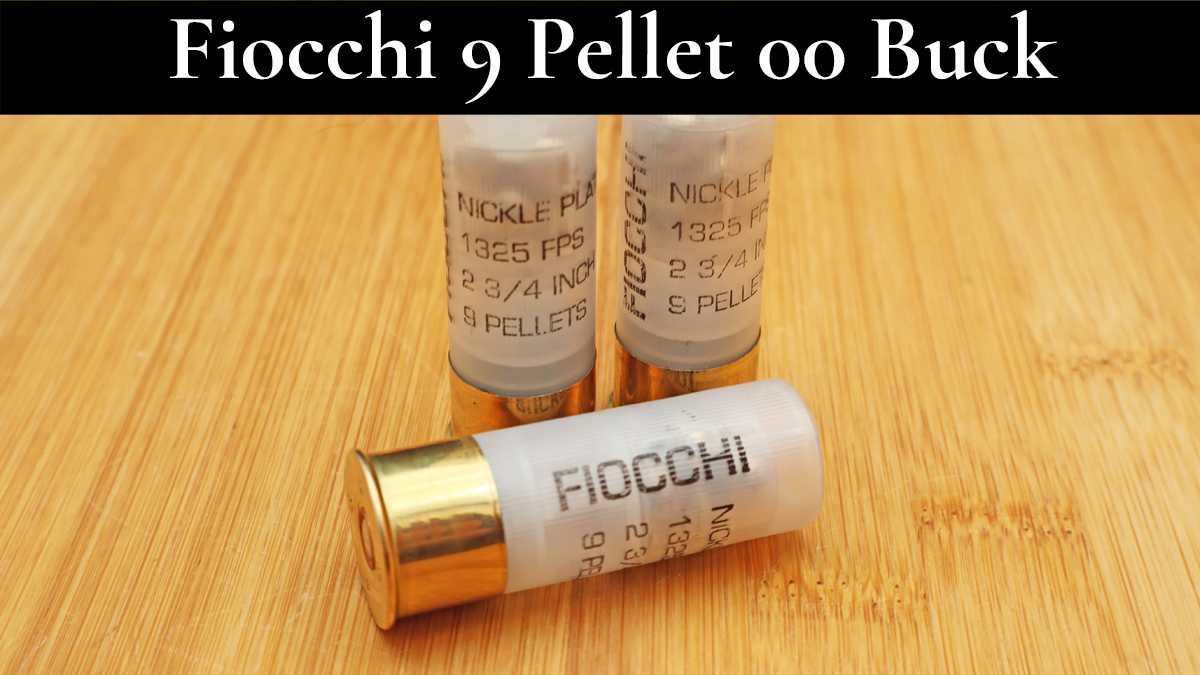
- Payload: 9 nickel plated 00 Buck pellets
- Advertised Velocity: 1325 FPS
- Wad Type: Standard wad & shot cup
- Cost Per Round: $1.00
Hopping right into it, the Fiocchi 9 Pellet 00 Buck did pretty poorly, but that was expected.
Dispersion:
- 25 yards: 20″, but off the target
- 20 yards: 14″
- 17 yards: 9.25″
- 15 yards: 9.5″
- 10 yards: 6″
- 7 yards: 3″
The patterning sucked. It did manage to keep all of the pellets on paper at every distance, aside from 25 yards. At 25 yards, I could not find my 9th pellet anywhere on the target, which again, is not unexpected.
While not a burn down or big reliability test, the Fiocchi 9 pellet was totally reliable, and had rather light recoil. That said, there are no real redeeming qualities to this stuff, aside from the cheapish cost. As they say, you get what you pay for.
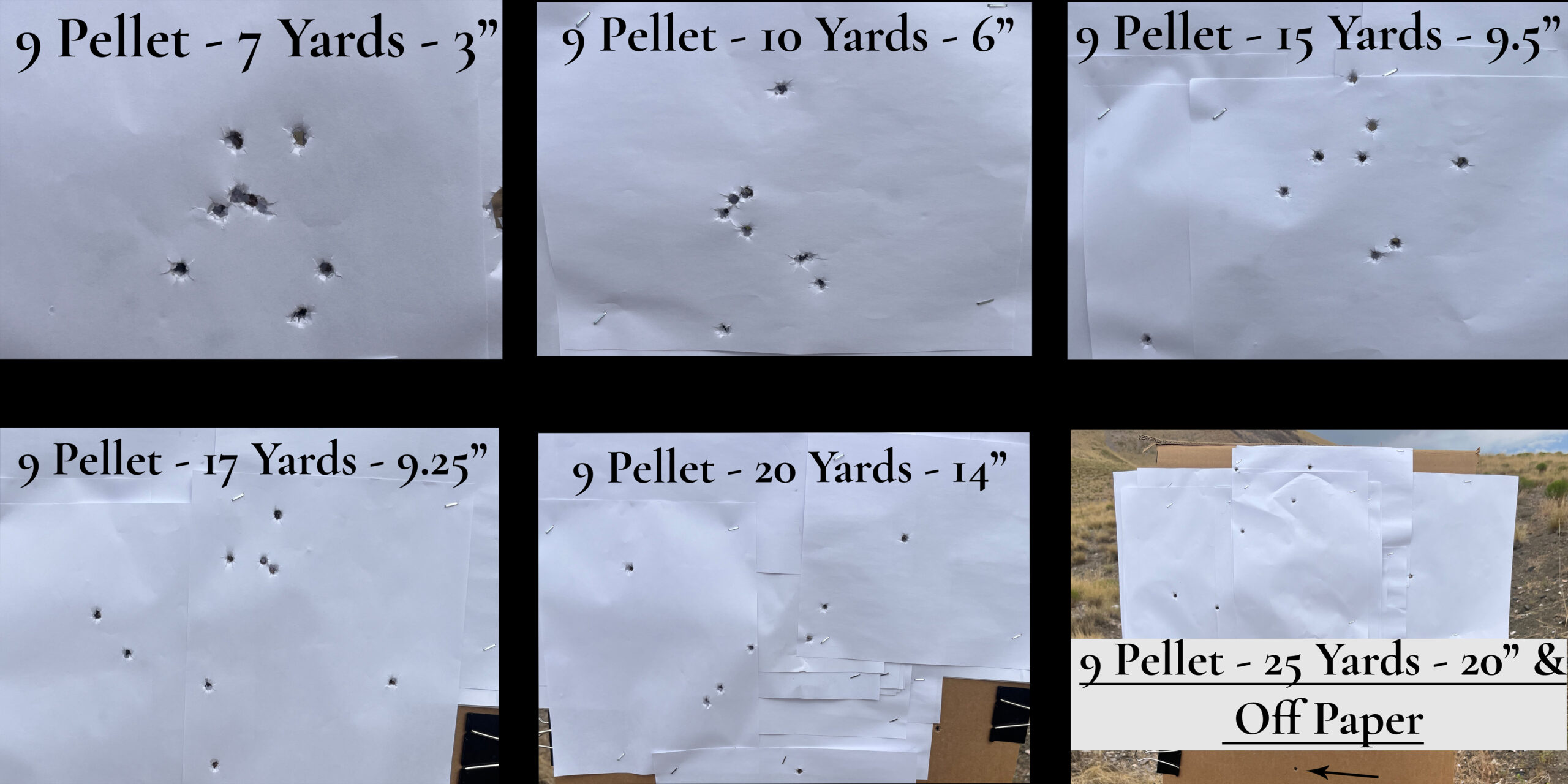
How well did the Critical Defense fare?
Hornady Critical Defense
Hornady’s Critical Defense buckshot has been on the market for a number of years. It has some good things going for it, and it’s a load that I’ve found to pattern pretty well in my A300.
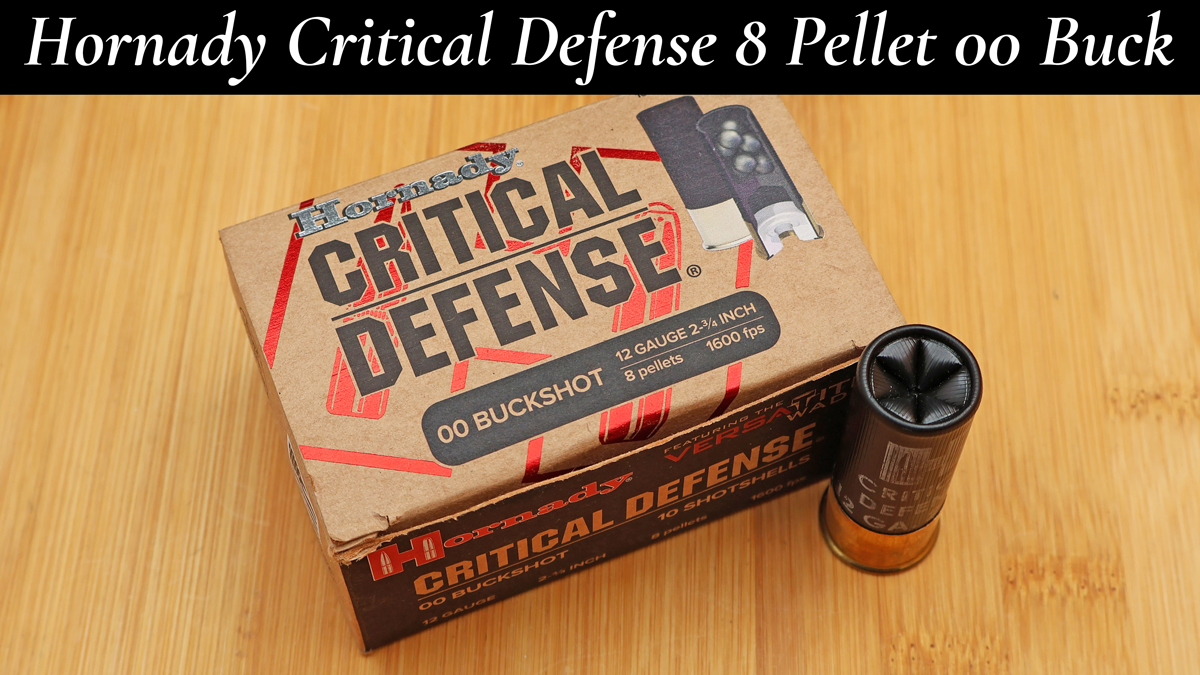
- Payload: 8 un-plated lead 00 Buckshot pellets
- Advertised Velocity: 1600 FPS
- Wad Type: Versatite Wad
- Cost Per Round: $1.70
One of the big draws of the CD is that it uses the Versatite wad, which is very similar in design to the FliteControl wad. There are some downsides with the Hornady load, such as the increased velocity, un-plated shot, and lack of a shot buffer. I’ll touch on those later down the article, but I do think that they play a part in how the patterning went.
Dispersion:
- 25 yards: 12.5″
- 20 yards: 6.25″
- 17 yards: 8.5″
- 15 yards: 11.75″
- 10 yards: 2.5″
- 7 yards: 4.5″
The CD did considerably better than the control load, but worse than in my patterning last year. I chock it up to some of those deficiencies with the load, namely the uncoated buckshot, higher velocity, and lack of a shot buffer/filler. Perceived recoil is not bad, being ever so slightly harsher than the control load. Reliability was flawless, and has been on every instance that I’ve shot the Critical Defense through my A300.
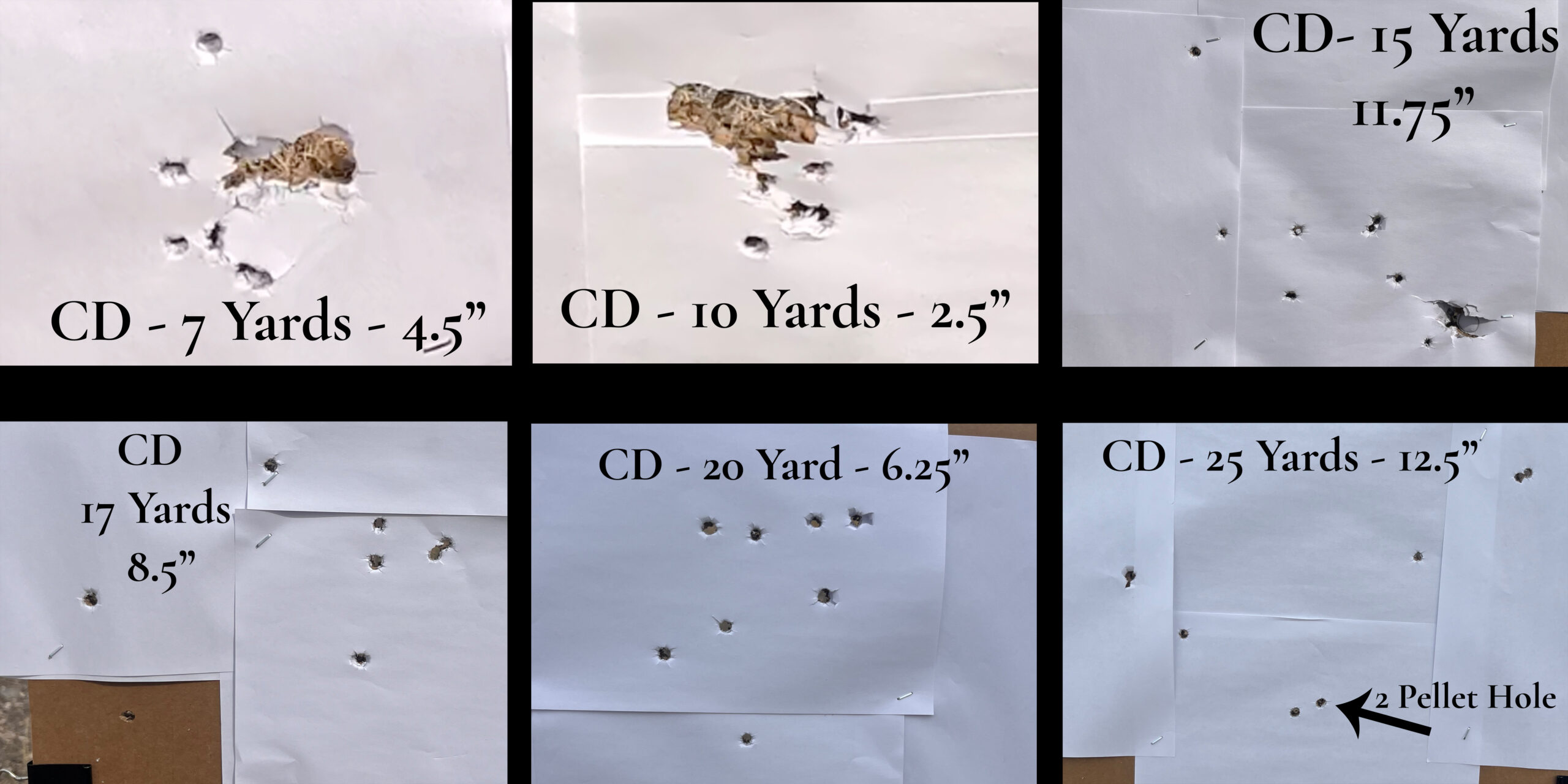
The CD is an improvement over the 9 pellet 00 Buck, but how does the FliteControl compare?
Federal FliteControl 8 Pellet
Federal FliteControl (8 pellet variety) has an almost mythical aura around it. It’s known to pattern extremely well, be reliable, and to have light recoil. However due to the poor availability, can be hard to come by, which really only increases the mystique.
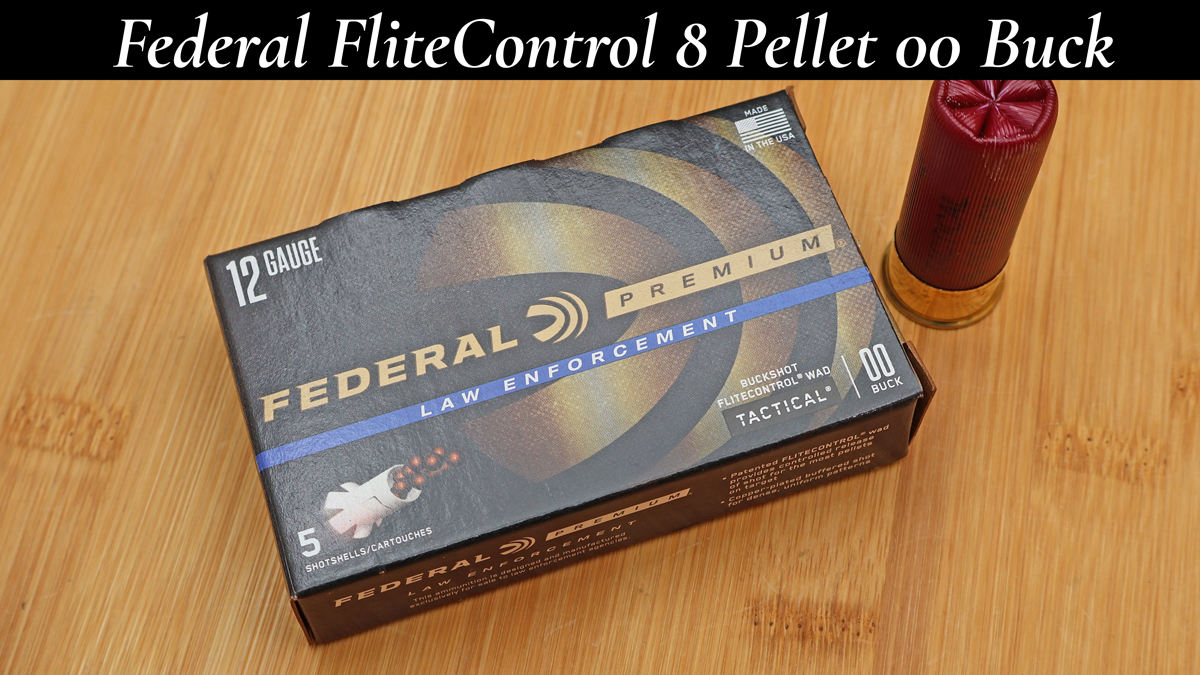
- Payload: 8 copper plated 00 Buckshot pellets
- Advertised Velocity: 1145 FPS
- Wad Type: FliteControl Wad
- Cost Per Round: Variable, $1.25-$1.50 depending on availability
Flight control is all about tight patterning. All of the elements of the shell (plated buckshot, buffer compound, longer wad with more petals, and lower velocity loading) play a part to make this a tight shooting load. In my shotgun, this certainly rang true.
Dispersion:
- 25 yards: 4.8″
- 20 yards: 5.25″
- 17 yards: 5.5″
- 15 yards: 3.25″
- 10 yards: 3″
- 7 yards: 2″
It’s not often that I’m impressed with things in the firearm world, but I was impressed here. The Federal FliteControl did as well as I had hoped, and that’s excellent. As far as I’m concerned, the only issue with the ammo is the availability. The lots that I tested were sold as LEO trade-ins (still factory sealed, but resold ammo), and it can be hard to find the load in stock. The ammo isn’t even listed on Federal’s site these days, only available via retailers or vendors.
Oh, the FC was the softest shooting load of the bunch, and was 100% reliable too.
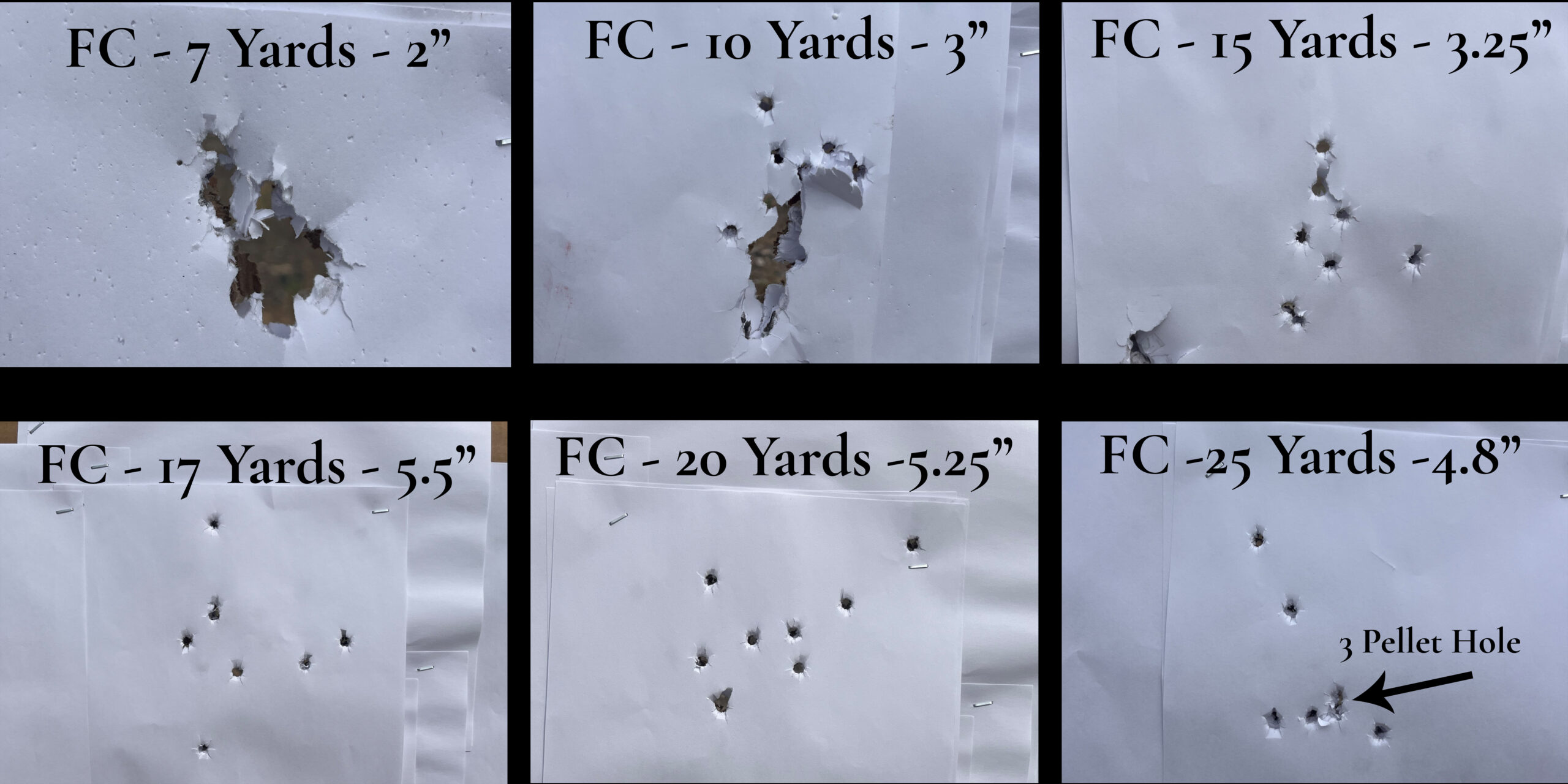
I’m happy with how the testing went, so lets talk results and comparisons.
Results – FliteControl Vs. Critical Defense
The results are pretty simple.
Both the Critical Defense and FliteControl patterned much better than the 9 pellet control load. Between those two loads, the FliteControl patterned a whole lot tighter than the Critical defense. I ended up ordering a second case of FC after my testing, so that load really does have my vote. That said, I still like the CD, especially given the availability of the ammo compared to FliteControl, but the FC is the better performer and better load between the two.
I think that the CD performed worse for a number of reasons. The load has the right pellet count and wad to be a good patterning shell, but the lack of the extra steps from the FC makes a big difference. With the pellets being uncoated, they’re more likely to deform, or to send one off as a flier, opening up the dispersion. Additionally, the lack of a buffer certainly plays a part, as that compound helps to keep the buckshot separated in the wad. Closing it out, the increased velocity will compound the issues with the pellets bouncing, leading to a more open group.
How much better though?
Math
One of my goals with this testing was to be more scientific, and that’s where the math comes in.
To compare the loads mathematically, I did a simple calculation. I took the mean dispersion for each load, and used that to compare the loads.
- Control 9 pellet mean: 10.96″ (Note: I used 24″ as my measurement for 25 yards, as my 9th pellet was not on paper)
- Hornady Critical Duty: 7.67″
- Federal FliteControl: 3.97″
Using these numbers, we can easily see how much better or worse each load patterned in comparison than on another.
- Hornady Critical Duty patterned 30.1% tighter than the 9 Pellet, but 93.2% more open than the FliteControl.
- Federal FliteControl patterned 64% tighter than the 9 Pellet, and 48.2% tighter than the Critical Defense.
Now, for the kicker:
- The Fiocchi 9 Pellet patterned 143% more open than the Critical Defense, and 276% more open than the FliteControl.
Needless to say, but the 9 pellet load patterned like crap in comparison to CD and FC. Even with the CD being pretty middling, it’s still not a bad load, and still ranks pretty highly in my book. FC 8 pellet is the king though, and I don’t think that can be contested.
The Verdict
This testing was extremely informative, and quite fun to do. The Federal FliteControl 8 pellet as well as I hoped, the Critical Defense, was a little underwhelming, and the 9 pellet sucked, but that was to be expected. I’d easily recommend the FliteControl (only the 8 pellet LE13300 variety, the 9 pellet LE 13200 tends to pattern poorly), if you can find it. The CD patterns worse in my gun, but still patterns to an acceptable degree, and is much more available on the store shelves. For 9 pellet 00 Buck, I’d just avoid it as a whole.
As for the testing, there is one thing that I would have preferred to have done, and that was to have shot 3 rounds at every distance. With this, I’d have more data to provide, but I would have also tripled the time. With that thunderstorm coming in, I just did not have the time to do so.
All of that said, it is important to pattern your shotgun, regardless of what ammo you choose to use. Every shotgun is a unique specimen, and you should know how yours does.
Video Work
I did a video in which I cover this data, and show some of my shooting footage from testing too!
Additional Reading & Patreon Link
Wanna learn more about the A300 and other scatterguns? We’ve got you covered!
- Dan’s A300 Ultima Patrol Review
- Savage Renegauge Security Shotgun Review
- Reptilla Aimpoint ACRO & Steiner MPS Mount Review
- Aridus Industries Bolt Release For A300 & 1301 Review
If you’d like to support me on Patreon, I’ve got the link for that here. Nearly everything that I do on Primer Peak is paid for out of my own pocket, and my content is not shilled or driven by manufacturers or companies. If you decide to donate, I’d really appreciate it, as it would allow for me to continue to bring you quality work.
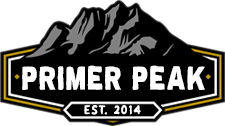

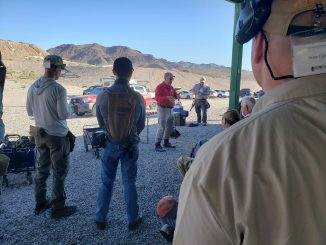


Nice read & breakdown. Thanks!
I don’t see it being better than Federal FliteControl but if time allows in the future, doing this analysis for one of the Winchester Defender 12-gauge loads would be nice.
Thanks for the kind words!
As far as I’m concerned, any shotgun patterning testing is good to see. I tried out some of the Winchester stuff last year (patterned it on my YT Channel, but it was not as scientific as this), and I was not impressed. That said, more information is always good!